What is a Lower Back Pain?
Lower back pain is a commonly experienced condition that affects the lumbosacral region of the spine. It is characterized by discomfort and can be debilitating. This type of pain can be caused by injury, certain activities, or medical conditions. It can affect people of all ages for various reasons. Treatment options for lower back pain include using the RICE principle, pain medications, and Physical therapy.
The lumbar region, also known as the lower back, is the area below the ribcage and is part of the spine. It is a complex structure consisting of interconnected bones, nerves, joints, ligaments, and muscles that work together to provide support, strength, and flexibility. However, this complexity also makes the lower back susceptible to injury and pain.
Lower back pain can be classified as either acute or chronic. Acute muscle pain in the lower back starts suddenly and lasts for up to 6 weeks, while chronic muscle pain develops over a longer period and lasts for more than 3 months, leading to ongoing problems.
Anatomy
Structures of the Low Back:
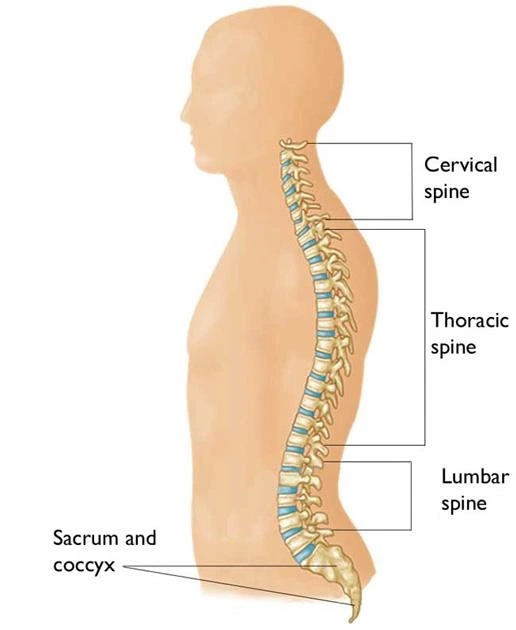
- Lumbar Spine: The lumbar spine is the main component of the lower back and consists of five vertebrae (L1-L5). These vertebrae play a vital role in supporting the upper body and providing stability. Each vertebra has a spinous process, a bony prominence that shields the spinal cord from impact trauma.
- Sacral Spine: The sacral spine is situated between the buttocks and consists of the sacrum bone. The sacrum meets the iliac bone of the pelvis, forming the sacroiliac joints.
- Discs: Discs are located between the vertebrae and act as shock absorbers. They provide cushioning and allow for smooth movement of the spine.
- Ligaments: Ligaments surround the spine and discs, providing stability and support to the lower back.
- Spinal Cord and Nerves: The spinal cord extends down the spinal column from the brain and is composed of nervous tissue. It facilitates signal transmission from the brain to the limbs.
- Paraspinal Muscles: These muscles are located in the lower back and play a crucial role in supporting and stabilizing the spine.
- Internal Organs: The lower back also houses important internal organs of the pelvis and abdomen. The spine and surrounding muscles protect these organs.
- Skin: The skin around the lumbar area acts as a barrier and provides sensory feedback.
The low back performs several essential functions, including:
- Structural Support: The lower back provides the structural support necessary for carrying the weight of the upper body.
- Movement: The complex structure of muscles, ligaments, tendons, discs, and bones in the lower back enables various movements such as bending, extending, and rotating.
- Protection: The lower back protects the spinal cord, nerves, and internal organs of the pelvis and abdomen.
The low back exhibits the following range of motion:
- Forward Flexion: Normally 80-90°
- Extension: 20-30°
- Lateral Bending: 20-30°
- Rotation: 30-40° in each direction
It is important to note that excessive movement can increase the risk of injury, such as disc prolapse, especially when lifting heavy weights.
Understanding the anatomy and function of the low back is crucial in diagnosing and treating low back pain. The complex interplay of various structures makes the lower back susceptible to injuries and pain. Maintaining proper posture, engaging in regular exercise, and seeking professional advice can help prevent and manage low back issues.
Causes of Lower Back Pain
Muscle Strain and Ligament Sprain:
Low back muscle sprains or strains can occur suddenly or develop slowly over time from repetitive movements. These strains happen when a muscle is stretched too far and tears. Sprains occur when ligaments are over-stretched or torn, which affects the connective tissues that hold the bones together.
Common causes of muscle sprains and strains include lifting heavy objects and twisting the spine while lifting, sudden movements that put excessive stress on the lower back (such as a fall), and sports injuries that involve twisting and large forces of impact. Poor posture over time can also contribute to muscle strain and sprain.
Lumbar Herniated Disc:
A lumbar disc can herniate when the soft interior protrudes through the tough outer layer and irritates a nearby nerve root. This can cause inflammation and compression of the nerve root, resulting in pain. Because the disc wall is densely packed with nerve fibers, a rupture in the wall can result in excruciating agony.
Degenerative Disc Disease:
With age, intervertebral discs lose hydration and wear down. When a disc loses hydration, it becomes less resistant to forces and can develop tears, leading to pain. This can eventually result in a weakened disc and herniation. Additionally, discs can collapse and contribute to spinal stenosis.
Facet Joint Dysfunction:
The facet joints are located behind each disc in the lumbar spine. These joints are encircled by a capsular ligament and have cartilage in between the bones. When these joints become painful, it can lead to disc pain.
Sacroiliac Joint Dysfunction:
Strong and low-moving, the sacroiliac joint eases stress and absorbs shock between the upper and lower bodies. It joins the sacrum at the base of the spine to each side of the pelvic bone. When the sacroiliac joint becomes inflamed (sacroiliitis) or experiences too much or too little motion, it can cause pain.
Spinal Stenosis:
A disorder called spinal stenosis causes the spinal canal to narrow and puts pressure on the nerve roots. This can cause pain that radiates to the central, foraminal, or both areas and can affect a single level or multiple levels in the lower back.
Spondylolisthesis:
Spondylolisthesis is the result of one vertebra slipping on top of the other. There are five types of spondylolistheses, but the most common type is degenerative, resulting from a defect or fracture of the pars between the facet joints and mechanical instability. This can cause pain from instability in the back and compression of the nerves in the leg.
Osteoarthritis:
Osteoarthritis in the spine is the result of wear and tear on the discs and facet joints. It can cause pain, inflammation, instability, and stenosis to varying degrees. This condition can occur at a single level or multiple levels in the lower spine and is associated with aging and progresses slowly. It is sometimes referred to as spondylosis or degenerative joint disease.
Deformity:
Spinal deformities such as scoliosis and kyphosis can also cause lower back pain. These deformities occur when the discs, sacroiliac joints, facet joints, or spinal canal become damaged or compromised.
Trauma:
Acute fractures and dislocations of the spine can also cause lower back pain. This type of pain may develop after a trauma such as a motor vehicle accident or a fall and should be evaluated by a medical professional.
Compression Fracture:
A compression fracture occurs when a cylindrical vertebra collapses on itself, causing sudden pain. This type of fracture is most commonly associated with weak bones, such as in the case of osteoporosis. An increased risk of compression fractures is seen in the elderly.
Symptoms of lower back pain
The lumbar spine supports most of the weight of the upper body and consists of the body’s largest vertebrae. However, these lumbar vertebrae are highly susceptible to degeneration and injury.
L3-L4 level:
Nerve root pain at this level is characterized by shooting pain in the front of the thigh, accompanied by numbness and tingling. These pain and neurological symptoms can also radiate to the front of the knee joint, shin, and foot, although this is less common.
L4-L5 level:
Pain at this level typically manifests as sciatic pain in the back of the thigh, and there may be pain that extends to the calves or combines with axial low back pain.
L5-S1 level:
This level refers to the connection between the base of the spine and the sacrum, which consists of a few joints that provide support and flexibility. One of these joints is the lumbosacral joint, which allows the hip joint to move from side to side. The other joint is the sacroiliac joint, which has limited mobility and primarily absorbs shock from the upper body to the lower body. Pain at this level is generally caused by issues with these joints and from a compressed nerve root. It commonly leads to sciatica.
What is the diagnosis of lower back muscle pain?
History:
Before starting a physical exam of the lower back, the doctor will ask for information about your symptoms and medical history. They will inquire about your activity level, such as whether you lead an active or sedentary lifestyle. They will also ask about your work position, as sitting at a desk or standing in an assembly line for long periods can be relevant. Additionally, they will about your sleep habits, including the number of hours you sleep, your sleep position, and the quality of your mattress and pillow. The doctor will then observe your posture, noting whether you sit upright or slouch.
Palpation:
The doctor will palpate the lower back area by hand, checking for any muscle areas of tenderness, spasms, tightness, or joint abnormalities.
Neurologic exam:
As part of the diagnosis, the doctor will also perform a motor exam, which involves manually moving the hip joint, knee joint, big toe (extension-flexion movement), and ankle joint. The sensory examination includes testing your reaction to light touch, as well as other senses in the lower trunk, pinprick, buttock, and legs.
Range of motion test:
The doctor will ask you to bend and twist in certain positions to look for any movements that worsen or recreate pain or specific movements that are limited due to discomfort.
Reflex test:
The doctor will perform reflex tests on your legs to evaluate weakened reflexes and decreased muscle strength. Diminished reflexes may indicate a nerve root problem.
Leg raise test:
You will be asked to lie on your back and raise one leg as high and straight as possible. If you experience low back pain during this test, it may indicate a suspected herniated disc.
Diagnostic Imaging Tests:
Sometimes, the doctor may recommend diagnostic imaging tests if you experience severe pain that persists for two to three months and does not improve with nonsurgical treatments.
- X-rays: X-rays are used to check the spine’s bones and can help identify abnormalities such as arthritis, bone spurs, fractures, and tumors.
- CT scan/Myelogram: A CT scan provides a cross-sectional image of the spine, allowing doctors to examine it from different angles. A myelogram may be performed in conjunction with a CT scan, where dye is injected around the nerve roots to enhance the clarity of the image.
- MRI (Magnetic Resonance Imaging scan): An MRI provides a detailed image of spinal structures without using radiation. It helps doctors detect abnormalities in soft tissues such as muscles, ligaments, and intervertebral discs. MRI is also used to locate misalignments and joint overgrowth in the spine.
- Injection studies: Fluoroscopic-directed injections of local anesthetic and steroid medications can help doctors confirm the source of the pain.
Risk factors for lower back pain:
- Age – As we get older, discs in the spine lose flexibility and elasticity, making them more susceptible to injury. Older people are also more at risk of developing spinal stenosis (narrowing of spaces in the spine) and osteoarthritis, both of which can cause lower back pain.
- Fitness level – Weak core (abdominal and back) muscles fail to properly support the spine and lead to poor posture. Lack of exercise leads to tight hamstrings and hip flexors, which put extra strain on the lower back. Good core strength and flexibility reduce strain on the back.
- Excess weight – Being overweight or obese causes the abdomen to pull forward, increasing the arch in the lower back. This puts extra pressure on the facet joints, sacroiliac joints, and discs, making them more likely to get injured or deteriorate. Losing excess weight can significantly reduce lower back strain.
- Pregnancy – The growing uterus shifts the center of gravity forward, arching the lower back. Relaxin hormones loosen pelvic joints and ligaments in preparation for childbirth. Changes in posture put extra stress on the SI joint and spine.
- Occupation – Jobs with heavy lifting, whole body vibration, awkward postures (bending, twisting), or prolonged sitting or standing put repetitive strain on the back over time. Improper lifting technique is a common cause of disc herniations.
- Mental health – Depression, anxiety, and other mental health disorders are bidirectional with back pain (pain contributes to mental health issues and vice versa). Stress and muscle tension exacerbate pain.
- Genetics – Disc degeneration, facet joint osteoarthritis, and other anatomical back problems have hereditary components. Genes involved in disc components and inflammatory responses affect risk.
- Chronic diseases – Osteoarthritis, rheumatoid arthritis, and fibromyalgia contribute to back pain through inflammation, joint/bone deterioration, and nerve sensitization. Managing the diseases can help reduce pain.
Ergonomics for preventing and managing lower back pain
Proper Lifting Techniques:
- Stand close to the object with a wide stance and your feet planted. Keep your back straight and bend at the hips and knees to squat down.
- Lift the object using your leg muscles, keeping it close to your torso. Instead of bending your back, turn your entire body around.
- Keep the weight as close to your center of gravity as possible to reduce stress on your lower back. Carry heavy loads against your body rather than in your hands.
- Limit lifting to objects you can carry easily. Use assistive equipment for heavier items.
- Avoid lifting above shoulder height or below knee level. This puts strain on the back.
Good Posture:
- Stand and sit tall with your ears, shoulders, and hips aligned. Don’t slouch or hunch forward.
- Use lumbar support for the natural curve in your lower back. A pillow, rolled towel, or special cushion can help.
- Adjust your workstation so your elbows are close to your body and wrists straight when typing.
- Avoid sitting or standing for too long. Take regular breaks to walk around.
Proper Seating:
- Use an ergonomic chair that supports the lower back curve and allows both feet to rest flat on the floor.
- Avoid cross-legged sitting – this twists the spine and pelvis.
- Adjust the seat height and backrest to support good posture and reduce slumping.
Workplace Adjustments:
- Place frequently used items within easy reach to avoid excessive bending and twisting.
- Vary tasks and take micro breaks to avoid sustained postures.
- Ensure work surfaces are at the proper height – use risers if needed.
- Consider using a sit-stand desk arrangement.
Disease Around the Low Back
Numerous medical conditions can cause back pain, including:
- Cauda equina syndrome: This syndrome involves spinal nerve roots at the lower end of the spinal cord. Symptoms include dull pain in the lower back and upper buttocks, numbness in the buttocks, genitalia, and thighs, and possible bowel and bladder function disturbances.
- Spinal tumors: Tumors on the spine can press against nerves, leading to back pain.
- Spinal infection: A spine infection can cause a fever and a tender, warm area on the back.
- Spina bifida: This neural tube defect occurs when the brain, spinal cord, and/or meninges do not fully form in infants.
- Paget’s disease of bone: This condition, of unknown cause, disrupts normal bone remodeling and weakens bones, potentially causing localized bone pain and deformity.
- Ankylosing spondylitis (AS): AS is a kind of arthritis that mostly affects the spine, resulting in joint discomfort and inflammation; in more severe cases, the growth of new bone can cause fusion and immobility.
- Rheumatoid disease: Like rheumatoid arthritis, other diseases can also cause pain in the lower back and other joints.
- Other infections: Pelvic inflammatory disease, bladder infections, and kidney infections may contribute to back pain.
- Sleep disorders: Individuals with sleep disorders are more prone to experiencing back pain.
- Shingles: Nerve-related infections, such as shingles, can result in back pain depending on the affected nerves.
Treatment for lower back pain
Home Treatments
RICE – This acronym stands for Rest, Ice, Compression, and Elevation which are simple at-home treatments. Rest the back from strenuous activity. Apply ice packs to the area for 15-20 minutes to reduce inflammation. Use a compression bandage to provide support. Elevate the legs above heart level to minimize swelling.
Back braces – Wearing a rigid back brace can provide some comfort and stability to the back after an injury. However, extended use may lead to back muscle weakness.
Mindfulness meditation – Meditation techniques help patients cope with chronic back pain by reducing stress, and anxiety, and altering the perception of pain. Practices like mindfulness, deep breathing, and guided imagery may provide relief.
Acupuncture – Fine needles are inserted into specific pressure points along the back and legs to provide pain relief in some patients. It aims to correct imbalances in the body’s energy flow to reduce pain signals.
Medical Treatments
Muscle relaxants – These medications provide short-term relief by relaxing tight, painful back muscles. They have central nervous system effects and should be used cautiously.
OTC pain relievers – Over-the-counter options like NSAIDs (aspirin, ibuprofen) and acetaminophen can alleviate inflammatory and nerve pain when used for short periods.
Opioids – Prescription narcotics and opioids may be considered for acute severe back pain on a very limited basis due to risks of dependency and side effects.
Steroid injections – Epidural steroid injections deliver anti-inflammatory corticosteroids around compressed spinal nerves. They provide temporary pain relief for some patients.
Additional therapies – Other options include prescription NSAIDs, chiropractic adjustments, TENS units, radiofrequency ablation, and surgery if conservative measures fail.
Massage Therapy
- It helps relieve muscle spasms and tightness contributing to back pain
- Increases blood flow to promote healing of damaged muscles
- Should be gently applied using oil for 5-10 minutes, 3 times per day
- Best done 2-3 days after the initial injury and following RICE principle
Electrotherapy
Used when pain persists after initial treatment
- Ultrasound – Uses sound waves and gel applied to painful areas for 5-10 minutes to reduce swelling and pain
- SWD, IFT, TENS – Use electrical currents through electrodes/pads on the skin over 10 minutes to relieve muscle spasms
- Traction – Gradually pulls and stretches the spine using pulleys and weights to realign spinal structures. Provides relief only during the application.
Manual Manipulation
- Spinal adjustments and manipulations are done by chiropractors or other providers
- Aims to improve mobility and reduce stiffness using varying speeds and forces
- It can help relieve pain but long-term benefits unclear
Exercise Therapy
- Helps strengthen core muscles, improve flexibility, and correct posture issues
- Aerobic exercise provides cardiovascular benefits and helps manage weight
- Physical therapists create individualized exercise programs for each patient
- Low-impact options like swimming, walking, and yoga are good choices
Exercise Therapy for Lower Back Muscle Pain
After following the RICE (Rest, Ice, Compression, Elevation) principle for 2-3 days at home, receiving primary treatment, and taking pain medication, you will start to feel relief from the pain.
Once you start to feel comfortable and the pain is reduced, it is recommended to engage in exercise therapy, which helps to alleviate muscle weakness and tightness.
Exercise therapy for muscle pain consists of stretching and strengthening exercises.
Stretching exercises for lower back pain
Stretching exercises are effective in relieving muscle tightness while strengthening exercises help to address muscle weakness.
Here are some guidelines for stretching exercises:
- After undergoing electrotherapy for 2-3 days under the supervision of a physical therapist and experiencing pain relief, the therapist will guide you on stretching exercises to further alleviate muscle tightness.
- These stretching exercises should only be performed once the pain has subsided and you feel comfortable.
Piriformis Stretches
The following stretches are effective for targeting the piriformis muscle in the backside. It is important to perform these stretches in a supine position.
- Start by lying on your back.
- Cross one leg over the opposite thigh to create a figure four shape.
- Lower your buttocks gently to the floor.
- Hold this position for 30 seconds.
- Repeat this stretch 3 times in 1 session, and aim for 3 sessions per day.
Knee-to-Chest Stretch
- Lay flat on your back with your feet flat on the ground and both knees bent.
- Keep your left knee bent and extend the right leg straight out along the floor.
- Pull your right knee towards your chest, clasping your hands behind your thigh at the top of your shinbone.
- Lengthen your spine towards your tailbone and avoid lifting your hips.
- Maintain this position for a duration of 30 to 1 minute.
Kneeling Back Stretch
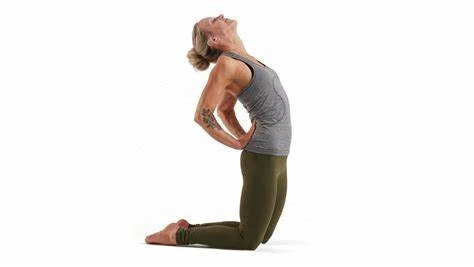
- Start this exercise on your hands and knees, with your knees hip-width apart or your shoulders directly over your hands.
- Round your back and pull your belly button towards your spine, tilting your lower back towards the floor.
- Hold this stretch for 5 seconds.
- Then gently rock backward, lowering your buttocks as close as possible to your heels.
- Make sure you are holding your arms out in front of you.
- Hold this stretch for 5 seconds.
- After That, rock gently back up to the first position.
- Repeat this sequence 3 times in 1 session, and perform 3 sessions per day.
Modified Seated Side Straddle
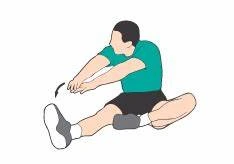
- Sit with both legs flat against the floor, extended out in front of the body.
- Place your feet far enough apart to form a “V” shape with your legs.
- Bend your left leg and bring your left foot up to touch your right knee, allowing your left knee to fall out away from your body.
- Keep your back straight, bending from the hip joint, and reach forward towards the toes of your right foot.
- As you lower your head to your right knee, slowly rotate your spine to bring your hands to your right ankle and shin.
- Maintain this stretch for 30 seconds, and then let go for another 30.
- Repeat this sequence 3 times in 1 session, and perform 3 sessions per day.
Lower Back Rotation Stretch:
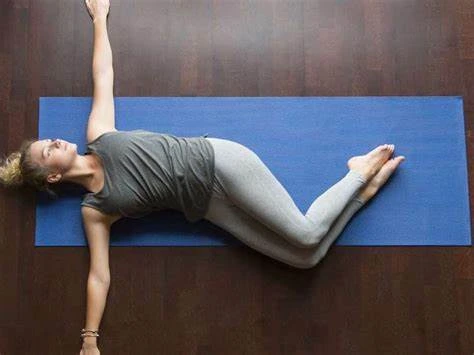
- Bend your knees while lying on your back with your feet flat on the ground.
- Keep your shoulders flat on the floor and your knees together as you slowly roll them to the right side of your body.
- Return your knees to the starting position after holding for five seconds, and then gradually allow them to roll to the left side of your body.
- Return to the beginning position after holding for ten seconds.
- Repeat this sequence 3 times in 1 session, and perform 3 sessions per day.
Lower back strengthening exercises
Supermans
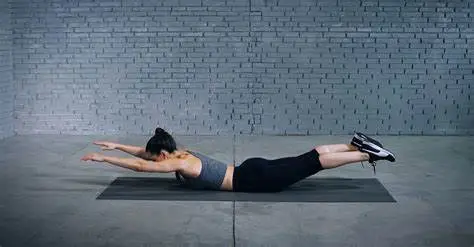
- Begin by lying face down on your stomach with arms extended overhead and legs straight behind you.
- Engage your abdominal and gluteal muscles.
- Inhale and simultaneously lift your arms, legs, and chest a few inches off the floor. Reach your arms forward and legs back.
- Exhale and hold the position for 2 seconds, squeezing your shoulder blades together and contracting your core.
- Inhale again and slowly lower back down to the starting position.
- Repeat for 10 repetitions. Throughout the exercise, keep your neck in alignment with your spine.
Partial Curls
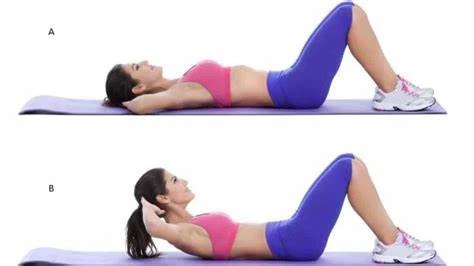
- To begin, lie on your back with your arms at your sides, knees bent, and feet flat on the ground.
- Pull your belly button toward your spine to contract your abdominal muscles.
- Inhale and slowly curl your head, shoulders, and upper back off the floor. Avoid pulling on your neck.
- Exhale and hold this contracted position for 5 seconds, keeping your core engaged.
- Inhale and slowly lower back down to the starting position, one vertebra at a time.
- Repeat for 10 reps, focusing on using your abs to lift you and controlling the descent.
Bird-Dog
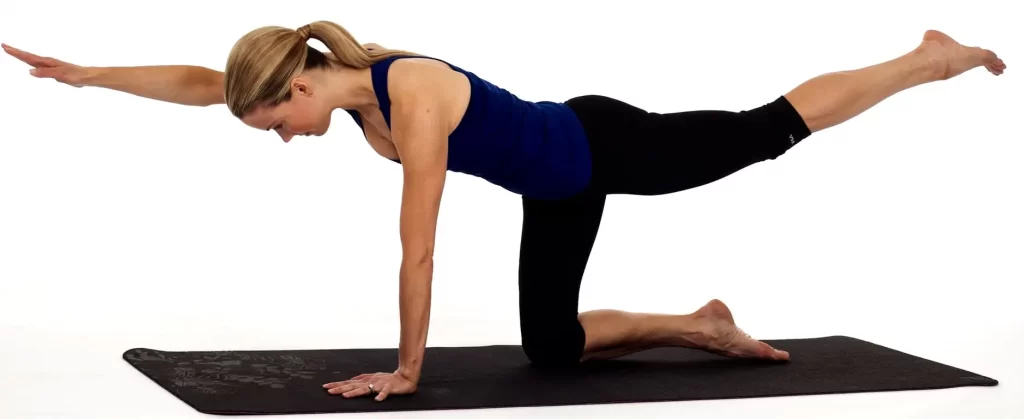
- Beginning on your hands and knees, place your wrists squarely beneath your shoulders and your knees beneath your hips.
- Engage your core to keep your back flat and stable.
- Exhale and extend one arm forward and the opposite leg back until parallel to the floor.
- Inhale and hold for 5 seconds, keeping your hips square and spine neutral.
- Exhale and return to the starting position.
- Repeat for 10 reps on each side, preventing rotation of the hips/spine.
Plank
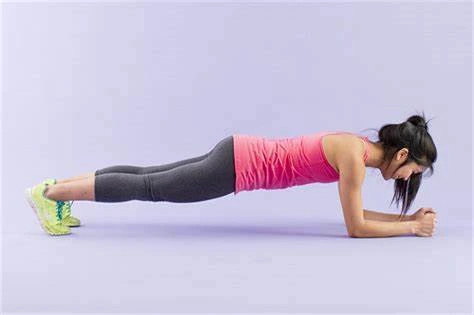
- Start in a push-up position with your wrists directly below your shoulders.
- Retain your shoulders and ankles in a straight line. Rest on your forearms and toes.
- Engage your core and glutes to prevent your hips from sagging or rotating.
- Hold the plank position for 30-60 seconds, breathing deeply.
- Complete 3 sets total, keeping proper form. Do not arch your back.
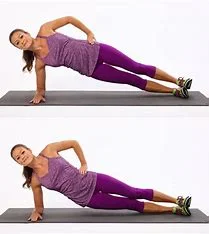
Side Plank
- Begin lying on your side, with your legs fully extended and stacked on top of each other.
- Prop yourself up on your forearm and elbow under your shoulder.
- Engage your core muscles to raise your hips off the floor, maintaining a straight line from head to feet.
- Hold this side plank position for 30 seconds, breathing deeply.
- Slowly lower your hips back down and repeat 2-3 times on each side.
- Keep your hips lifted and your spine neutral throughout. Do not lean or rotate.
Abdominal Crunches
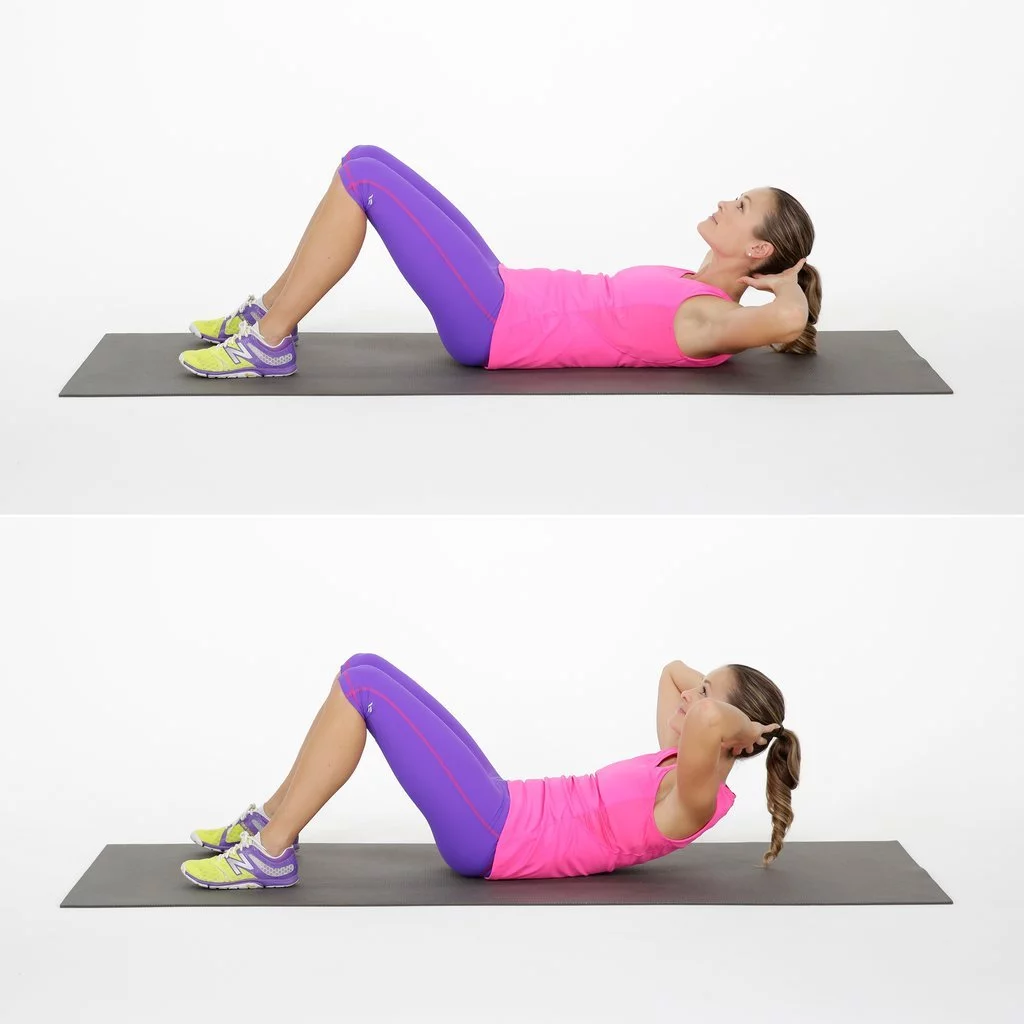
- Place your hands lightly behind your head while lying on your back with your knees bent and your feet flat on the ground.
- Pull your belly button in the direction of your spine to contract your abdominal muscles.
- Exhale and curl your torso up slightly using your abs, avoiding pulling on your neck.
- Hold the contracted position for 2 seconds, keeping the chin tucked and the neck stable.
- Inhale and slowly lower back down to the starting position, one vertebra at a time.
- Repeat for 10 repetitions, keeping the movement controlled.
- Focus on proper form rather than speed. Do not let your lower back arch up.
Cat/Cow
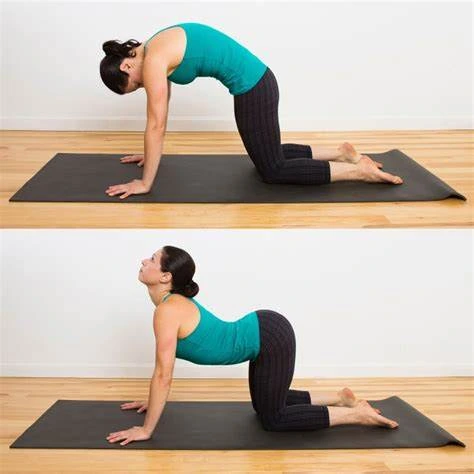
- With your back straight and relaxed, begin on your hands and knees, placing your wrists under your shoulders and your knees under your hips.
- Inhale and drop your belly toward the floor, lifting your chin and chest and arching your back like a cow.
- Exhale and raise your belly button toward your spine, rounding your spine and tucking your chin toward your chest like a cat.
- Repeat for 10 repetitions, coordinating the movement with your breath.
- Focus on flexing and extending the spine using your core muscles rather than moving from your lower back.
Bridges
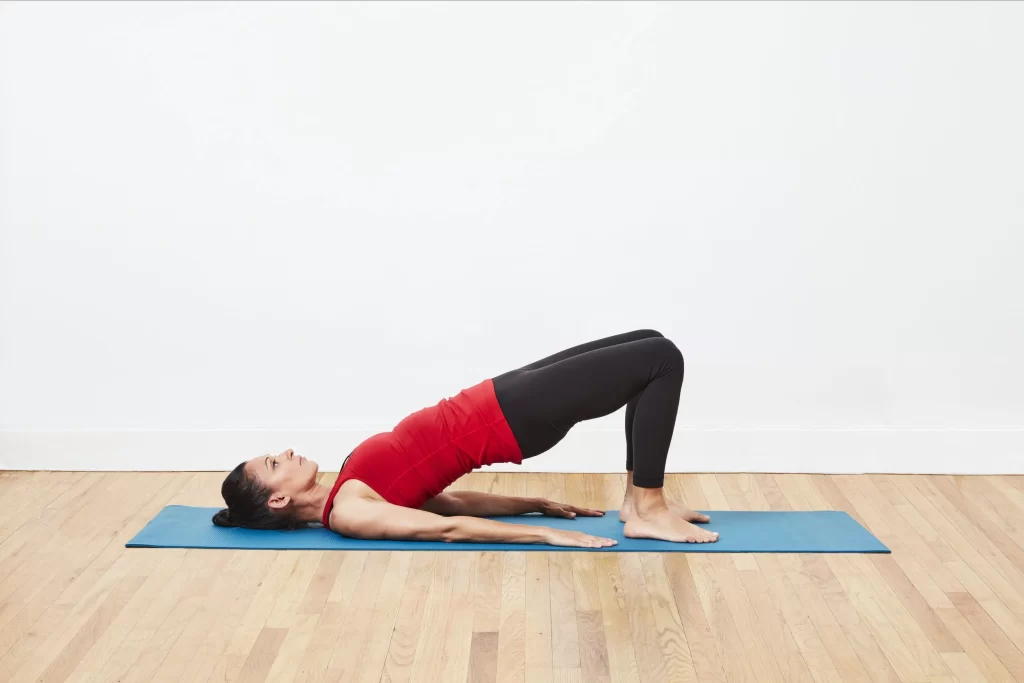
- Arrange your arms by your sides and lie on your back with your knees bent and your feet flat on the floor, hip-width apart.
- Activate your glutes and core. Once your shoulders, hips, and knees are all in a straight line, plant your feet firmly on the ground, exhale, and lift your hips.
- Squeeze your glutes and hold the bridge position for 5 seconds without letting your hips sag.
- Inhale and slowly lower your hips back down to the starting position, one vertebra at a time.
- Repeat for 10-15 reps, keeping your back flat and abdominals engaged. Do not overach your lower back.
Drawing-In Maneuver
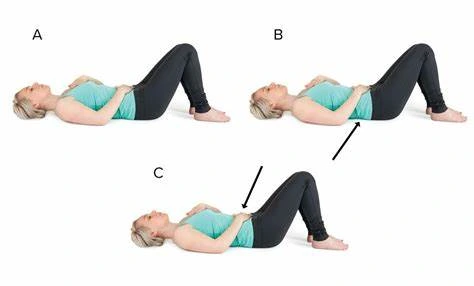
- Shoulders bent, place your feet flat on the ground, and lie on your back. Extend your arms out to the sides.
- Engage your transverse abdominis by drawing your belly button in toward your spine like you’re bracing your core.
- Hold for 10 seconds while breathing deeply.
- Relax your core and return to the starting position.
- Repeat for a total of 10 repetitions, fully releasing between each hold.
- Throughout the exercise, keep your back pressed onto the floor.
Pelvic Tilts
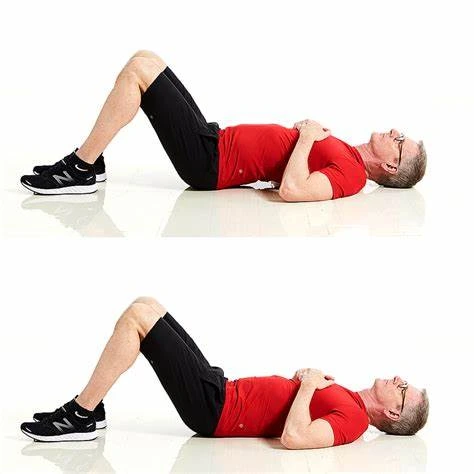
- Spread your arms by your sides and lie on your back with your knees bent and your feet flat on the ground.
- Engage your lower abdominal muscles and glutes to tilt your pelvis up slightly, pressing your lower back into the floor.
- Hold this posterior pelvic tilt for 5 seconds, keeping your upper back relaxed on the floor.
- Slowly lower your pelvis back to the neutral starting position.
- Repeat for 10-15 repetitions, breathing deeply throughout the movement.
- Avoid overarching your lower back. Keep the movement small and controlled.
Lying Lateral Leg Raises
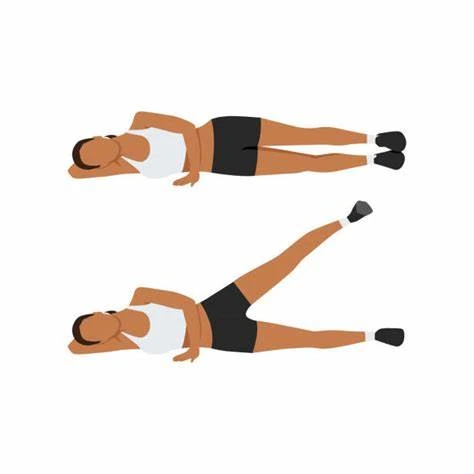
- Lie on your side with both legs extended, knees straight, and ankles together. Raise your head by using your lower arm.
- Keeping both legs straight, engage your core and raise your top leg upward toward the ceiling.
- Raise your leg only as high as is comfortable, being careful not to twist your pelvis.
- Hold for 2 seconds at the top of the movement before slowly lowering your leg.
- Complete 10 reps then carefully switch to the other side.
- Keep your pelvis still and leg straight throughout the exercise, working the outer thigh.
What is the surgical treatment for lower back muscle pain?
If medical and physical therapy treatments do not relieve the pain, the doctor may recommend surgical treatment.
Surgery is advised for individuals experiencing severe lower back pain that does not improve after 6 to 12 weeks. The decision to undergo surgery depends on the individual, and in rare cases, immediate surgery may be necessary for low back muscle pain.
Some surgeries for lower back pain include:
Decompression Surgeries:
- In this surgery, a portion of a facet joint is removed to provide better access to the nerve root and relieve nerve pressure.
- This surgery addresses issues such as a herniated disc and bone spur that are pressing on the nerve root from the spinal column.
Microdiscectomy:
- This minimally invasive procedure is performed for individuals with a lumbar herniated disc that leads to radicular leg pain (sciatica).
Laminectomy:
- This surgery involves removing part of the bone layer and soft tissue that is compressing a nerve and multiple nerve roots.
- Laminectomy is typically performed for individuals with leg pain and weakness caused by spinal stenosis, which is a result of changes in the facet joints, discs, and bone spurs.
- The procedure can be done using open or minimally invasive techniques, resulting in smaller incisions, minimal discomfort, and faster recovery before returning to work and other activities.
Lumbar Spinal Fusion:
- During this surgery, the soft tissues between two or more adjacent vertebral bones are removed and replaced with bone and metal.
- This allows the bones to grow together over time, resulting in a stable fusion and elimination of motion at the spinal segments.
- Fusion can be performed through posterior, anterior, lateral, or combined approaches.
- With the use of biologics, navigation, and implants, modern surgical methods have improved predictability and facilitated a quicker recovery and return to regular activities and work.
- Lumbar spinal fusion is used to treat various conditions including spondylolisthesis, stenosis, deformity, instability, degenerative disc disease, and fractures.
- It can also be used for sacroiliac joint dysfunction and fusion of the sacroiliac joint, although this is less common.
- Fusion surgery may also be used to treat tumors and infections, although these cases are rare.
Lumbar Artificial Disc:
- Disc replacement is an alternative to fusion surgery for symptomatic degenerative disc disease.
- It offers the potential for a quicker recovery and maintenance of spinal motion compared to lumbar fusion.
- Long-term data on the effectiveness of this procedure is still being collected.
Posterior Motion Device:
- The Coflex inter-laminar device is another alternative to fusion for stenosis and mild degenerative spondylolisthesis.
- The goal of this approach is to achieve similar results as fusion but with a smaller surgery and faster recovery.
- Long-term data on the outcomes of this procedure is still being collected.
Home remedies to relieve lower back pain
Heat Therapy
- Applying heat helps relax tight back muscles and increase blood flow. This helps ease stiffness and soreness.
- Use a heating pad, hot water bottle, or warm compress on the back for 15-20 minutes at a time. Repeat as often as every two to three hours.
- Heat wraps, patches, and thermal gels that stick to the skin are also available. Follow instructions for safe usage.
- Heat therapy works best for chronic back pain or muscle tension. Avoid direct heat after an acute injury.
Cold Therapy
- Ice or cold packs constrict blood vessels and reduce inflammation and swelling around an injury.
- Apply ice wrapped in a thin towel directly to the painful area for 10-15 minutes every 3-4 hours.
- Gel ice packs that mold to the shape of the back are very convenient. You can also use frozen vegetables.
- Use cold therapy in the first 24-48 hours after an acute back strain or injury to manage pain.
Epsom Salt Baths
- Epsom salts’ magnesium sulfate aids in muscle relaxation and inflammation reduction.
- Add 2 cups of Epsom salt to a warm bath and soak for 15-20 minutes to get magnesium absorbed through the skin.
- Can boost benefits by gently massaging the back while soaking to encourage muscle relaxation.
- Take Epsom salt baths 2-3 times per week when dealing with chronic back pain.
Anti-inflammatory Herbs & Spices
- Turmeric, white willow bark, devil’s claw, and boswellia contain anti-inflammatory compounds.
- Take these herbs as supplements or use turmeric liberally when cooking. Make teas from the herbs.
- Apply ginger, cayenne, or mustard seed oil topically as rubefacients.
- Use caution when taking herbal supplements and consult your doctor.
Tips for preventing lower back pain
Maintain Good Posture
- Stand tall with your ears, shoulders, and hips aligned. When standing or sitting, try not to slouch or hunch.
- Use lumbar support for your lower back curve when sitting. A small pillow or rolled-up towel can help fill the space.
- Adjust your workstation so your computer screen is at eye level and your elbows are close to your body when typing.
- When sitting for long periods, make sure your knees are slightly lower than your hips and feet are flat on the floor.
Exercise Regularly
- Build core strength with exercises like planks, bridges, and abdominal crunches. This supports the spine.
- Stretch tight hamstrings, hip flexors, and back muscles gently daily. Poor flexibility strains the back.
- Low-impact cardio like swimming, walking, or cycling helps manage weight and improves back endurance.
- Yoga is excellent for developing both strength and flexibility through poses and controlled breathing.
Practice Good Body Mechanics
- Avoid lifting heavy objects. If you must lift, squat close to the load and use your legs to power the lift.
- When picking things up off the floor, kneel on one knee rather than bending straight over at the waist.
- Carry items close to your chest rather than at your sides. Don’t twist your back – pivot your whole body instead.
- Sit correctly in your car with your back against the seat, knees bent at 90 degrees, and arms angled downwards.
Manage Your Weight
- Excess weight puts strain on your back muscles, joints, and discs. Aim to stay within a healthy BMI range.
- Follow a nutritious diet focused on lean proteins, vegetables, fruits, and whole grains. Stay hydrated.
- Supplement diet with regular exercise tailored to your fitness level and any back conditions.
Summary
Lower back pain is an extremely common issue that affects up to 80% of adults at some point in their lifetime. It can be acute or chronic, ranging from dull aches to severe debilitating pain. The lower back supports the weight of the upper body and enables various movements, hence it is prone to strain and injury. Typical causes include muscle or ligament injury, bulging/ruptured discs, spinal stenosis, arthritis, skeletal problems, excess weight, poor posture, and improper lifting techniques.
Symptoms involve localized low back pain as well as radiating leg pain, muscle spasms, reduced flexibility, and range of motion. Treatment focuses on OTC pain relievers, hot/cold therapy, massage, stretching, low-impact exercise, spinal adjustments if needed, and building core strength for support. Proper lifting mechanics and using assistive back belts can also help prevent recurrence.
For chronic lower back pain, weight loss, posture correction, physical therapy exercises, corticosteroid injections, and lifestyle modification are key. Surgery like laminectomy or spinal fusion may be a last resort option for severe disc herniation or nerve impingement unresponsive to conservative treatment. Learning proper body movements and maintaining a healthy weight are vital for avoiding lower back injuries.
FAQs
Which factors most frequently result in lower back pain?
The most common causes are muscle or ligament strains, bulging or ruptured discs, spinal stenosis, arthritis, skeletal irregularities, and extra weight putting strain on the back.
When should I see a doctor for lower back pain?
See a doctor if pain persists beyond a week, radiates down your leg, causes weakness in your legs, you have difficulty with urination, or experience fever/chills along with the pain.
What stretches help relieve lower back pain?
Some beneficial stretches are child’s pose, knee-to-chest, cat-cow pose, seated spinal twist, and laying on your back with knees bent and feet on the floor. Avoid painful stretches.
What exercises can help strengthen my back?
Effective back-strengthening exercises include bridges, planks, bird dogs, supermans, abdominal crunches, and pelvic tilts. Focus on core and glute exercises.
How long does it take for lower back pain to heal?
Acute back pain often resolves within 4-6 weeks with rest and conservative treatment. Chronic back pain can persist for 12 weeks or longer, especially if the underlying cause is not addressed.
Should I use ice or heat for back pain?
Use ice in the first 2 days after injury to reduce inflammation. Apply heat after 48 hours to relax muscles and increase blood flow. Avoid direct heat on an acute injury.
How can I improve my posture to avoid back pain?
Keep your ears, shoulders, and hips aligned when sitting and standing. Use lumbar support for your lower back curve. Adjust your workstation and car seat to support good posture.
What adjustments to my lifestyle can I make to avoid back pain?
Lose excess weight, exercise regularly focus on core strength, stretch tight muscles, practice good lifting mechanics, and take breaks from prolonged sitting or standing.
References
- Martel, J. (2023, March 30). Everything You Want to Know About Lower Back Pain. Healthline. https://www.healthline.com/health/low-back-pain-acute
- Clinic, M. P. (2024, February 8). Low Back Pain Detail And Physiotherapy Treatment. Mobile Physiotherapy Clinic. https://mobilephysiotherapyclinic.in/low-back-pain-physiotherapy-exercise/
- Professional, C. C. M. (n.d.). Lower Back Pain. Cleveland Clinic. https://my.clevelandclinic.org/health/diseases/7936-lower-back-pain
- Ladva, V. (2023, February 22). Lower Back Pain: Cause, Symptoms, Treatment, Exercise. Samarpan Physiotherapy Clinic. https://samarpanphysioclinic.com/lower-back-pain-treatment-exercise/#What_are_the_Symptoms_of_Lower_Back_pain

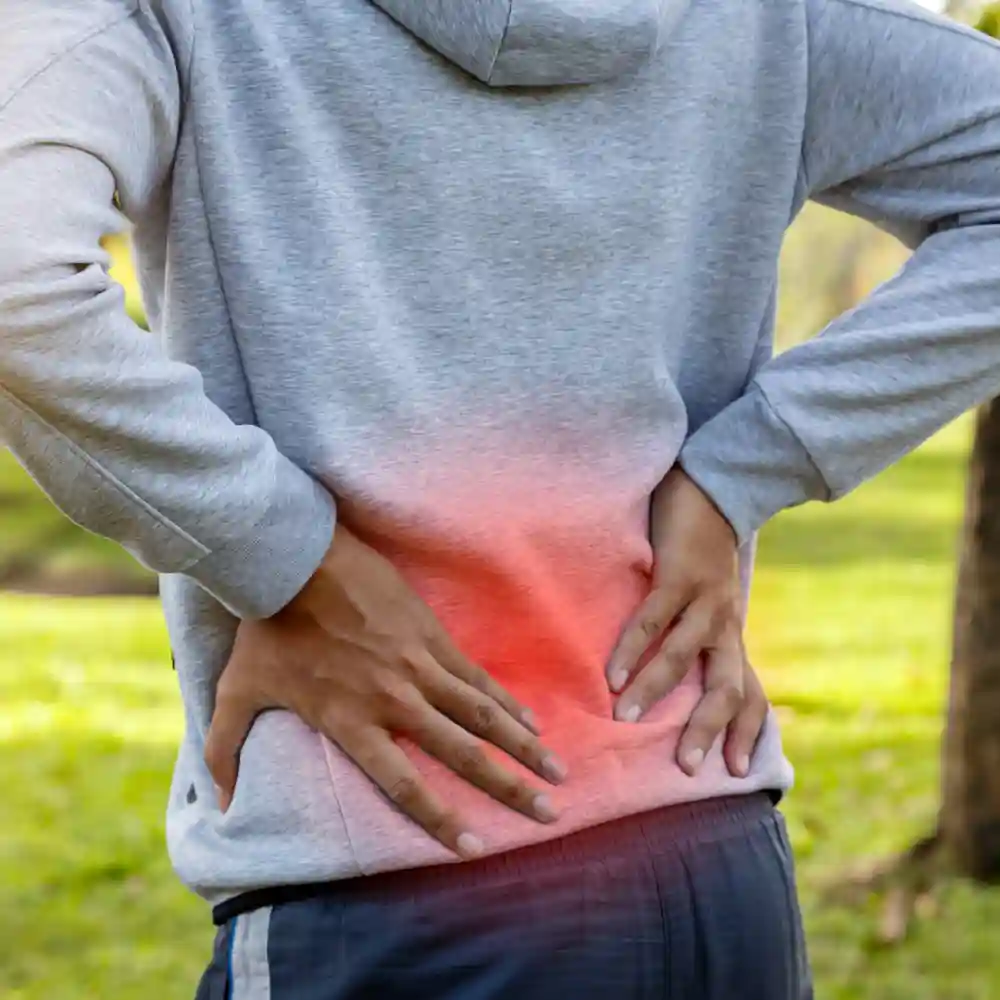
[…] In a number of musculoskeletal disorders, physical therapy has been shown to be beneficial in improving outcomes with regard to pain and function. Physical therapists can safely manipulate the spine to help patients with lower back pain. […]
[…] Lower Back Pain […]
[…] typically begins in the sacroiliac joints, causing lower back pain and stiffness, and can progress to involve other parts of the spine and even peripheral […]
[…] It was discovered that using TENS alone as an intervention was a very successful way to reduce low back pain. […]
[…] back. Reducing the amount of strain on your back is more effective than increasing it when managing low back pain. Walking quickly could be a better alternative for back pain than running […]
[…] research indicates that isometric activities may help with pain reduction for lower back pain, knee osteoarthritis, and neck […]
[…] range of clinical complaints have commonly participated in traction trials, including back-dominant lower back pain (LBP), leg-dominant LBP, or […]
[…] Lower back pain and osteoarthritis are two chronic conditions for which stretching may offer pain relief. Flexibility is an essential part of wellness and general health. Everyday activities would be much more difficult without the capacity to bend over, twist, or squat. Your range of motion and flexibility will improve if you perform stretching as a daily part of your routine. […]
[…] This muscle can change in length or stiffness, which can cause changes in posture and/or movement patterns that worsen lower back pain. […]
[…] the effectiveness of MET with control therapy in the treatment of patients with non-specific low back pain (LBP). It was found that among patient populations with non-specific LBP, the quality of randomized […]
[…] Lower back pain […]